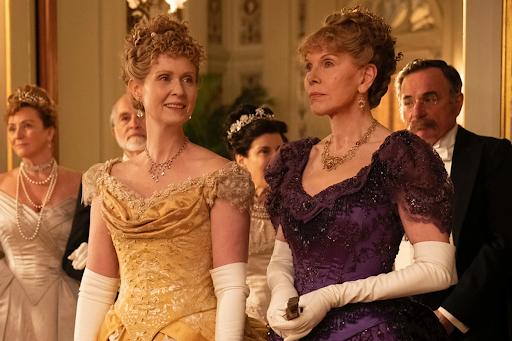Review: The Gilded Age Premier

Image Courtesy of The Sun/HBO
By Dean Robbins
“Never the new,” instructs Agnes van Rhijn (Christine Baranski) to her newly arrived niece, Marian Brook (Louisa Jacobson). Agnes is referring to money: new money and old money. Agnes is very much old money. The just-moved-in neighbors next door, led by robber baron George Russell (Morgan Spector) and his socially desperate wife, Bertha (Carrie Coon), are the newest money in New York City. Marian is unfortunately neither–she has no money, after her formerly wealthy father died with “about $30” to his name. Marian is now at the mercy of her wealthy aunts Agnes and Ada (Cynthia Nixon) after moving from Doylestown, Pennsylvania, but she has no respect for the social conventions Agnes and Ada keep sacred. Welcome to The Gilded Age!
Writer and executive producer Julian Fellowes is best known for his British megahit Downton Abbey, which has six seasons and two movies (one upcoming) under its belt. Fellowes has decided to do as the pilgrims did and come overseas for his follow-up. The Gilded Age is set in New York City, 1884. The Industrial Revolution is quickly changing the landscape of the country from railroads to bridges and a select few are getting brain-meltingly rich off of it. Old money, as represented by Agnes and Ada, has deep roots, including such period corporate buzzwords as “New Amsterdam” (pre-Revolution NYC heritage) and “the Continental Army” (colonial heritage). However, new money has the future of industry and technology. In The Gilded Age, it is not only the usual upstairs/downstairs tension as seen in Downton Abbey but also the fight over the past and future of the American aristocracy that forms the heart of the show’s drama thus far.
While Marian Brook is an important “in” for the audience into this time period as she discovers the world of new and old money alongside the viewers, The Gilded Age also has what Downton Abbey sorely lacked: a black perspective. Peggy Scott (Denee Benton), an African-American writer, finds herself with Agnes and Ada after helping Marian out of a tough spot. Through Scott, the viewer can see another dimension of division in this period; this time between black and white. The show also tackles the issue of race head-on with an additional spotlight on the tension between newly-freed African-Americans and newly-arrived European immigrants, the show’s 80-minute pilot episode sets up a shockingly wide breadth of perspectives and complexities that are sure to only get more interesting and insightful as the season progresses. As television for history buffs, this is top tier.
The period detail, as expected from Fellowes, is some of the best in the business. The costumes, hairstyling, and production design are all impeccable. Thanks to HBO’s generous budget allowances, there is a diverse selection of historically accurate and expertly created sets. These range from small-town train stops to palatial mansions to beach houses. If the show’s historical aspects pique your interest, HBO also has a very informative companion podcast available on most platforms, hosted by Turner Classic Movies host Alicia Malone and NYC history expert Tom Meyers.
Not everything here, however, is gold leaf. The Gilded Age, underneath all of its research and technical detail, is a soap opera. Soap operas are certainly entertaining, and I have personally consumed more Days of Our Lives than any eighteen-year-old safely should. However, the acting is undeniably stilted, and it is hard to ignore that everything is just a pretense for a series of increasingly complex dramatic situations. While the cast here is filled with great actors and no one does a bad job, dialogue often feels more like CBS primetime than HBO prestige television. In the face of every other aspect of the show, I do not see this as a reason to skip this show. It is just a bit disappointing in comparison.
All in all, this show is a must-watch for fans of period dramas or history! The Gilded Age debuts new episodes Mondays at 9 pm on HBO and is available streaming on HBO Max.






